I’m always searching for more ways to use up the okara (soy pulp) that I’m left with after making Soy Milk. Introducing Kongbiji Jjigae (콩비지찌개), a traditional Korean recipe that mixes okara with kimchi and mushroom-seaweed broth for a nourishing stew bursting with umami flavours. Suitable for vegetarians and vegans!
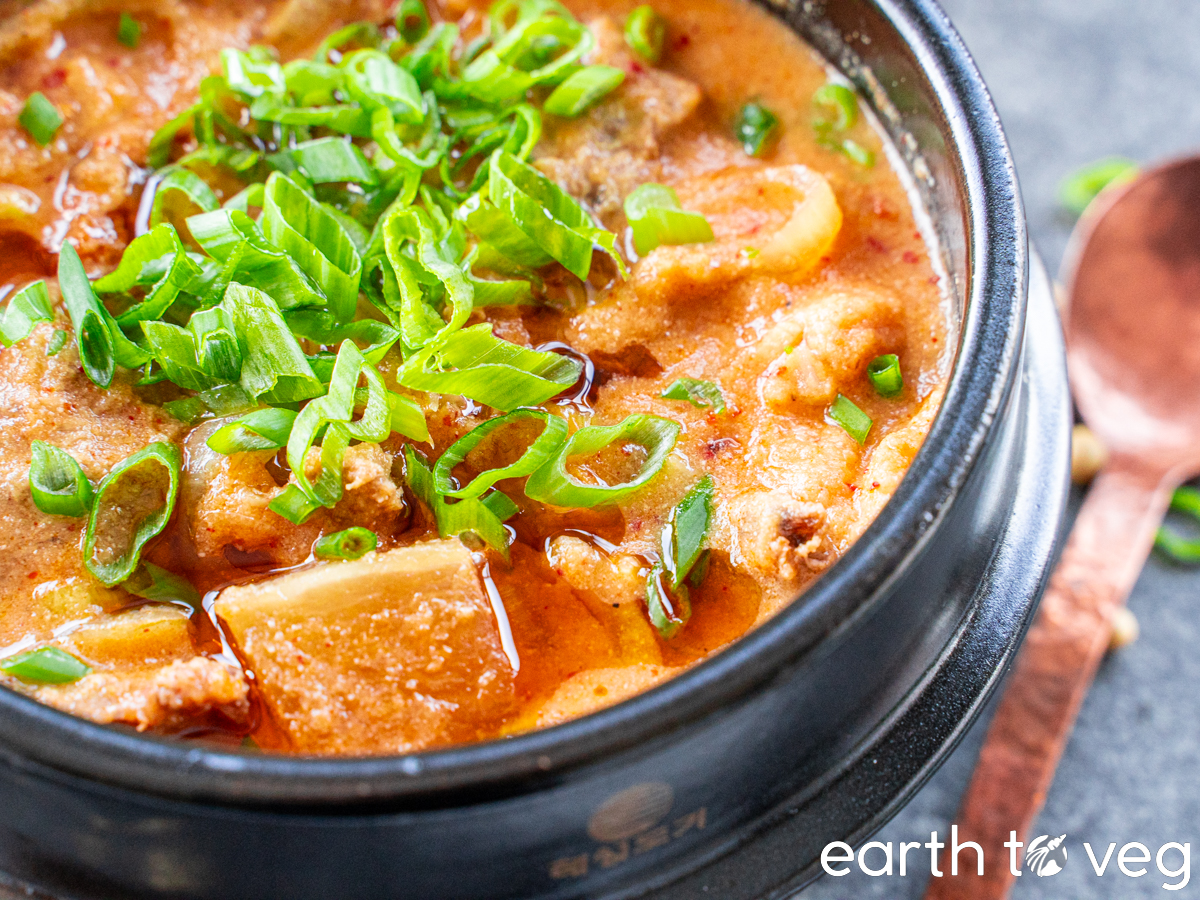
Why You’ll Love This Recipe
- Use up your leftover kimchi and okara. Kongbiji jjigae includes two ingredients that you might struggle to find uses for: really old kimchi, and okara soy pulp. As you know, I love finding ways to reduce food waste and use up every last bit of my provisions. I always seem to have a jar of okara kicking around in my freezer. If you make your own Soy Milk regularly, chances are you do too.
- Flavourful: Okara is bland on its own, but this dish is packed with umami-rich ingredients: kimchi, soy sauce, kombu (seaweed), shiitake mushrooms… it’s a great way to satisfy your spicy and savoury cravings. Kongbiji jigae is usually served with Steamed Rice so that the plain rice will take on the flavours of the stew as it gets mixed together. Pairing with rice also helps reduce the gritty mouthfeel of the dish.
Ingredients and Substitutions
A few important notes on some of the ingredients used in this Kongbiji-Jjigae:

Yuksu (육수) is a Korean soup stock (similar to Japanese dashi). It’s traditionally made from shiitake mushrooms, dasima seaweed, mu radish, anchovies, and onions. Anchovies can be left out to keep it vegan. The yuksu we’ll make in this recipe is simple, just seaweed and shiitake mushrooms. (Onions will be sautéed and added later in the recipe. I use my mom’s homemade kimchi, which contains radish already, so I’m not putting any more radish to my broth. However, you can feel free to dice up a few cubes of radish and drop it into your yuksu for a stronger umami flavour.)
Kimchi (김치): If you’re vegan or vegetarian, make sure to check the ingredients on your kimchi package for fish sauce, anchovies, or shrimp paste, which are commonly added to commercial kimchi. There are specially labelled vegan kimchi’s that you can find at Korean grocery stores or online. The longer kimchi sits, the more pungent it gets, and the more flavourful it is in stews. The texture will soften as it ages, but that’s why it’s perfect to use in cooked recipes like Kongbiji Jjigae or Soondubu Jjigae.
Kongbiji (콩비지) or just Biji (비지) is the gritty soy pulp that is leftover from straining Soy Milk. You might know it as okara, which is the Japanese name. This stuff still has lots of nutrition left in it, and it freezes and dries well. I’ve used it to make Vegan Sausages, Turkish Lentil Soup, and now kongbiji stew. The trick is not to use too much, or else it will make the dish taste dry and gritty. Make sure to follow the recipe measurements carefully.
Guk-Ganjang (국간장) aka Soup Soy Sauce is a special type of Korean soy sauce. It’s more salty and concentrated than other soy sauces, despite having a lighter colour. It’s perfect for seasoning vibrant soups and stews like this kongbiji-jjigae without affecting the colour of the dish. You can find guk-ganjang at Korean grocery stores or order it online, but you can also substitute it with regular soy sauce.
Tip: Depending on how salty your kimchi is, you might have to add more or less soy sauce to taste. I recommend over-salting your kongbiji jjigae slightly so that it mixes well into your rice when serving.
Vegan Beef is an optional ingredient and you can substitute it with fried tofu or smoked tofu. Kongbiji jigae is traditionally made with stewing meat (either beef or pork) but it’s easily modified to be vegan with a protein alternative. I like to use King’s Vegetarian Beefy Bites because they come seasoned with Asian spices and have a nice chewy texture. Another option I tried recently was the Beyond Steak Plant-Based Seared Tips. SO GOOD!
Gochugaru (고추가루) is dried Korean chili pepper, which you can buy as chili powder or chili flakes. Sometimes you’ll also find it labelled as kochukaru. Both the powder or the flakes will work perfectly in this recipe. Gochugaru is about half as spicy as regular chili powder or chili flakes. Aleppo pepper flakes are a great substitute. It’s completely optional; add as much or as little as you want depending on your spice tolerance.
Roasted Sesame Oil: NOT optional. Adds a delicious nutty aroma! Drizzle it on at the end of cooking like a finishing oil. (It’s like the Asian version of extra virgin olive oil, lol. Just a little splash brings out big flavours in dishes like Japchae, Vegan Egg Roll in a Bowl, Jajangmyeon, and Stinky Tofu Soup.) Kadoya brand is my go-to.
For a full list of ingredients and quantities, refer to the recipe card at the bottom of this post.
Step-by-Step Process

Step 1: Make the yuksu broth. Combine 1 cup water, 3 shiitake mushrooms, and a 4×4 sheet of kombu in a small ttukbaegi. Bring this to a simmer on medium heat.
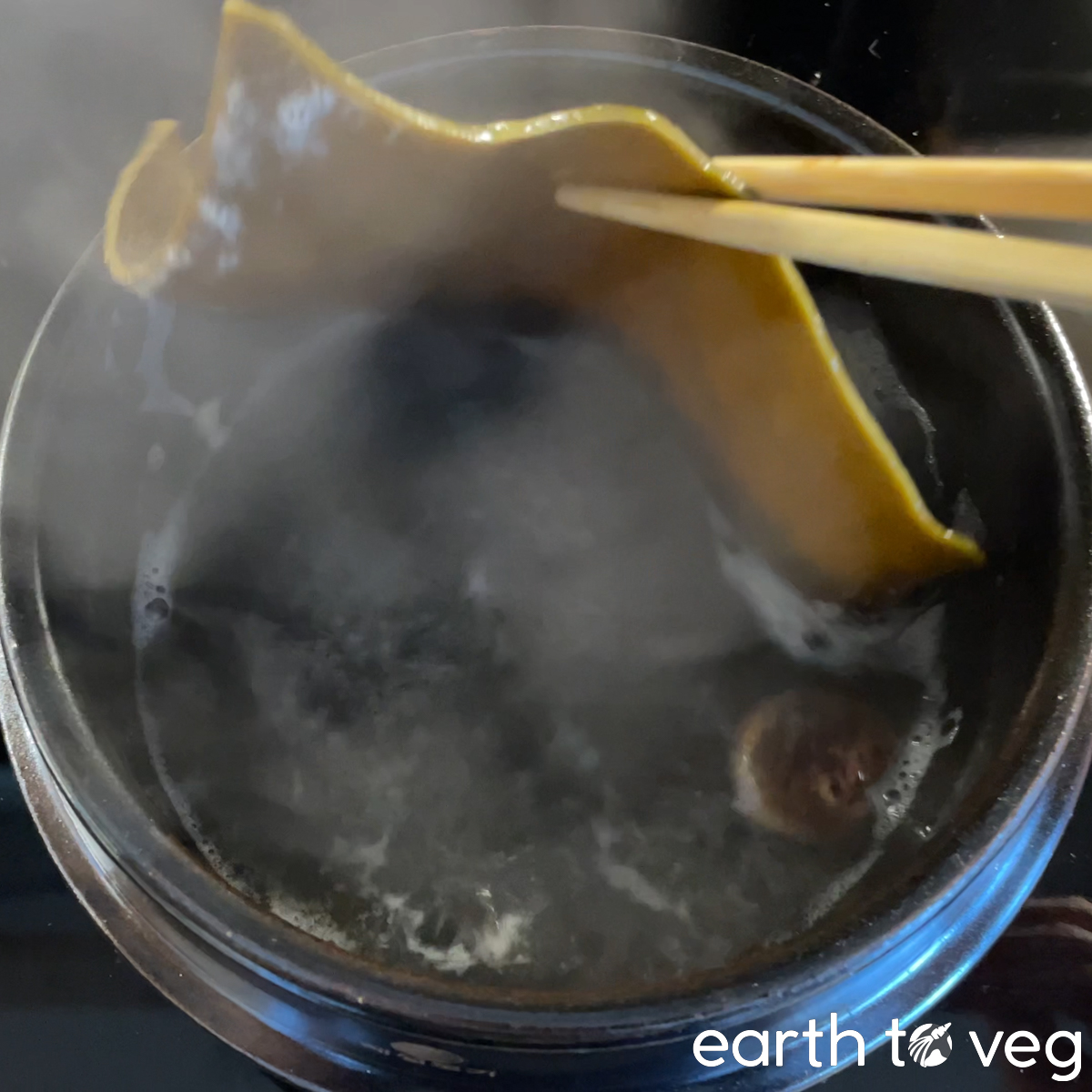
Step 2: Once the water begins to boil, remove the kombu. As kombu boils, it breaks down and releases compounds that turn the broth slimy and bitter.
Did you know: Ttukbaegi is a Korean earthenware pot that is commonly used for making jjigaes. You can also use a stock pot or small Dutch oven.
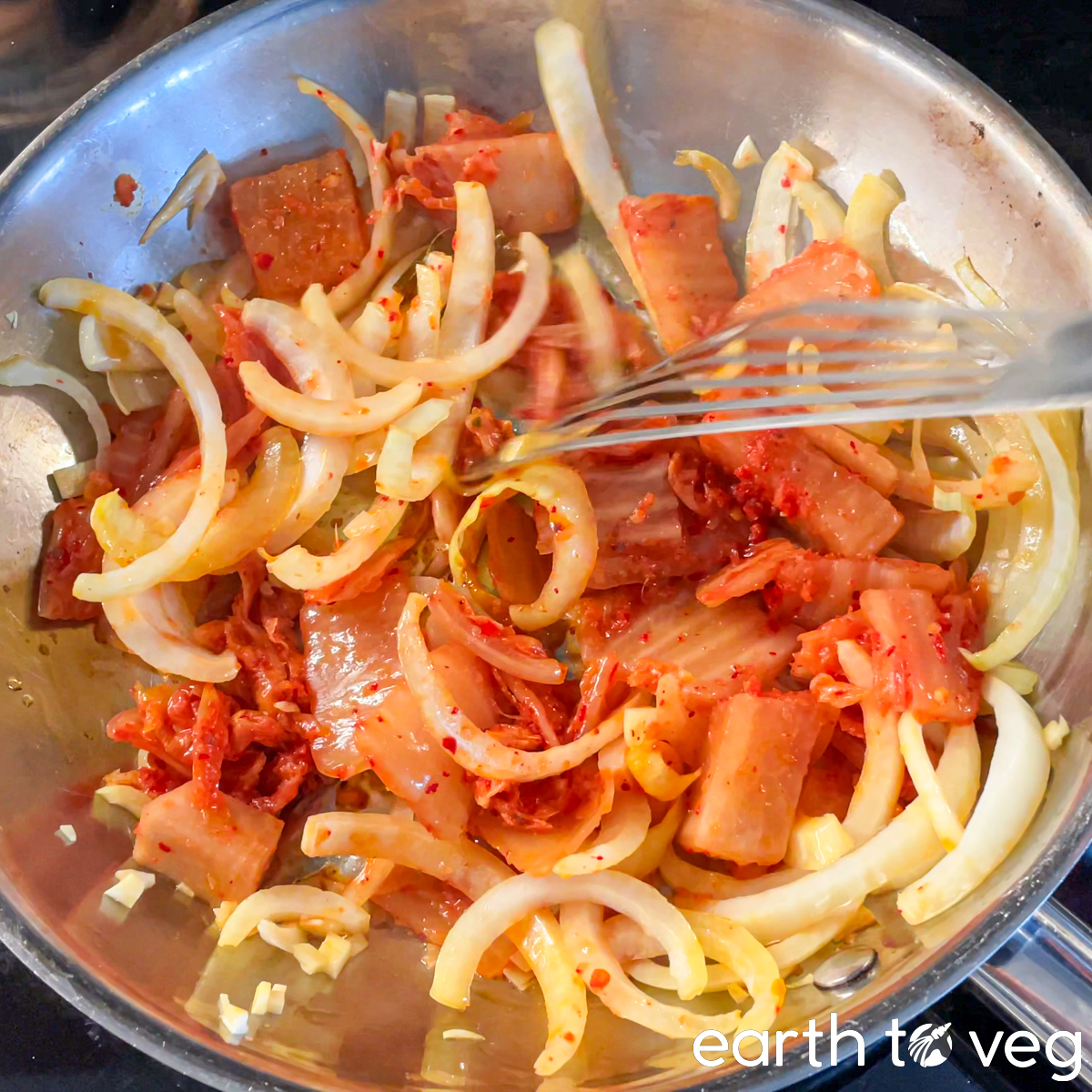
Step 3: Pour 1 tbsp of oil into a skillet on medium heat. Briefly sauté onion and garlic until aromatic, then add 3/4 cup of drained kimchi. Cook for a few minutes, then transfer this mixture into the ttukbaegi.
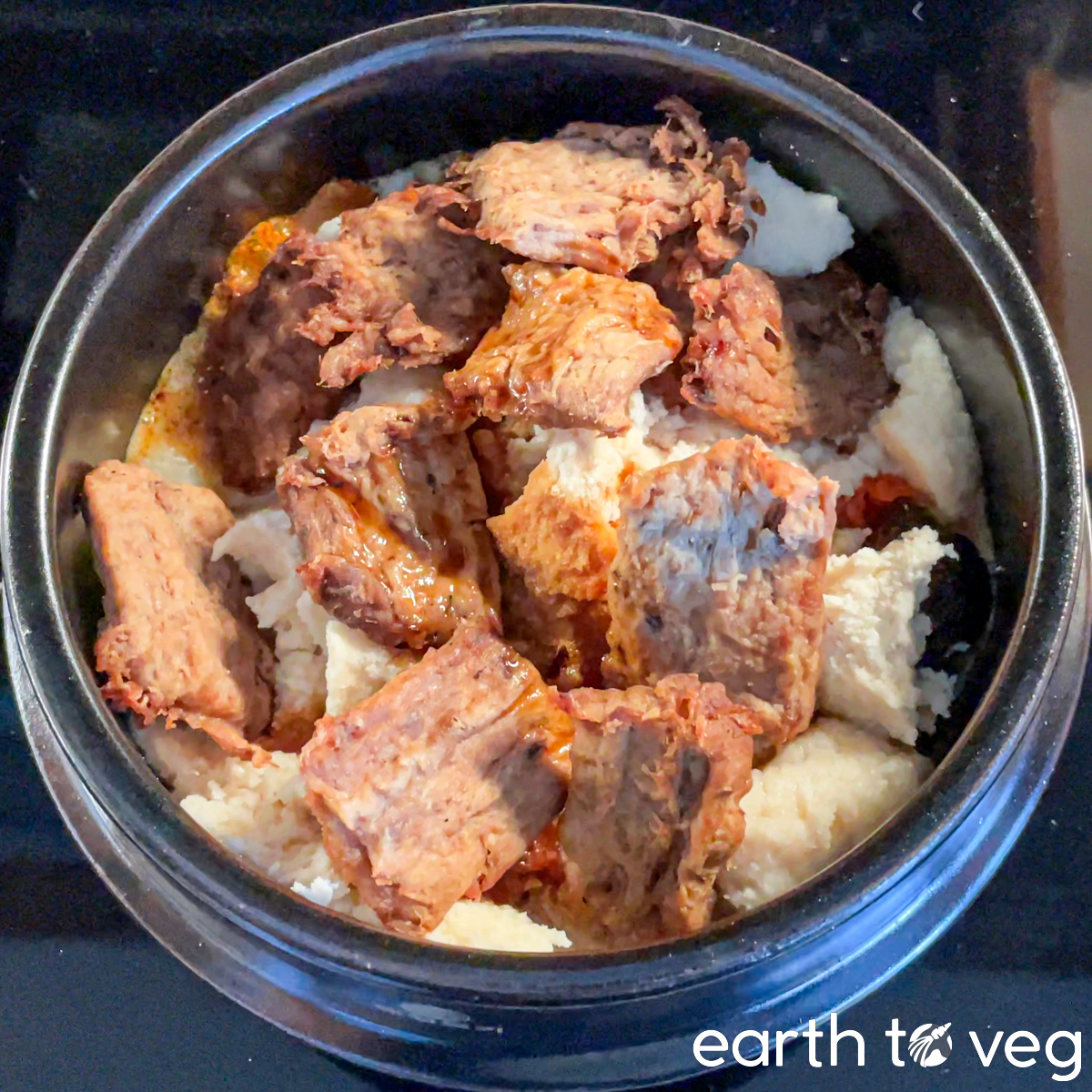
Step 4: Add the kimchi brine, black pepper, soy sauce, okara, and vegan beef. Simmer for 10 minutes, then turn off the stove and let the jjigae cook for another 5 minutes in the residual heat.
Tip: Be careful when handling ttukbaegi because the sides will become very hot during cooking.

Step 5: Taste the cooked kongbiji-jjigae for soy sauce, and add more if needed. If it looks too dry, you can add a bit more water.

Step 6: Garnish with scallions, gochugaru, and sesame oil. Taste for salt and add more soy sauce if needed. Serve while bubbling hot!
Make Ahead & Storage Tips
Refrigerator: Store kongbiji jjigae in a covered container for up to 5 days in the fridge.
Freezer: Kongbiji jigae freezes well! Thaw in the fridge overnight before reheating. (Store in single-serving containers to make defrosting easier. Otherwise, it may take a couple days to fully defrost.)
What to Serve with Kongbiji-Jigae
It’s an absolute must to serve kongbiji jjigae with steamed rice. Either brown or white rice will do, or even Korean multigrain rice. You can follow my recipe for cooking rice on the stove top.
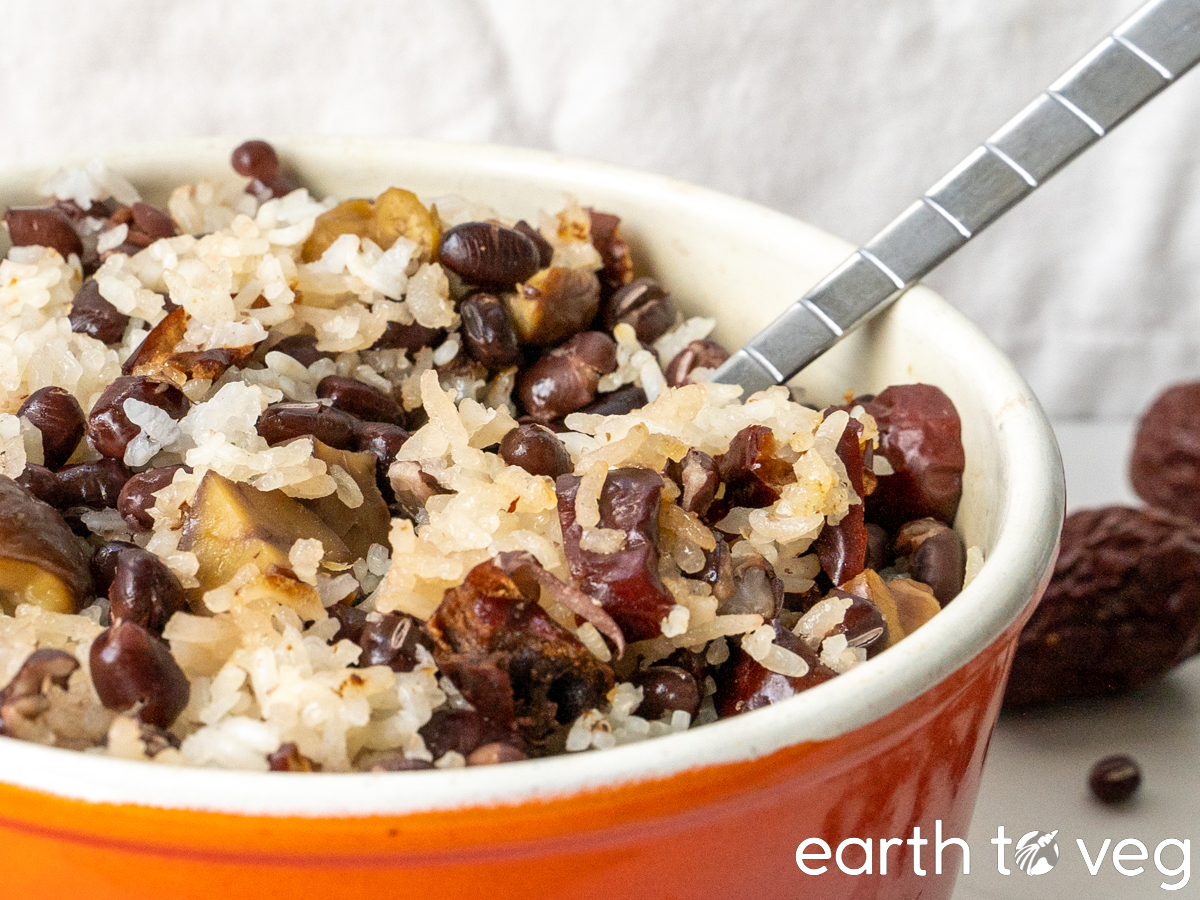

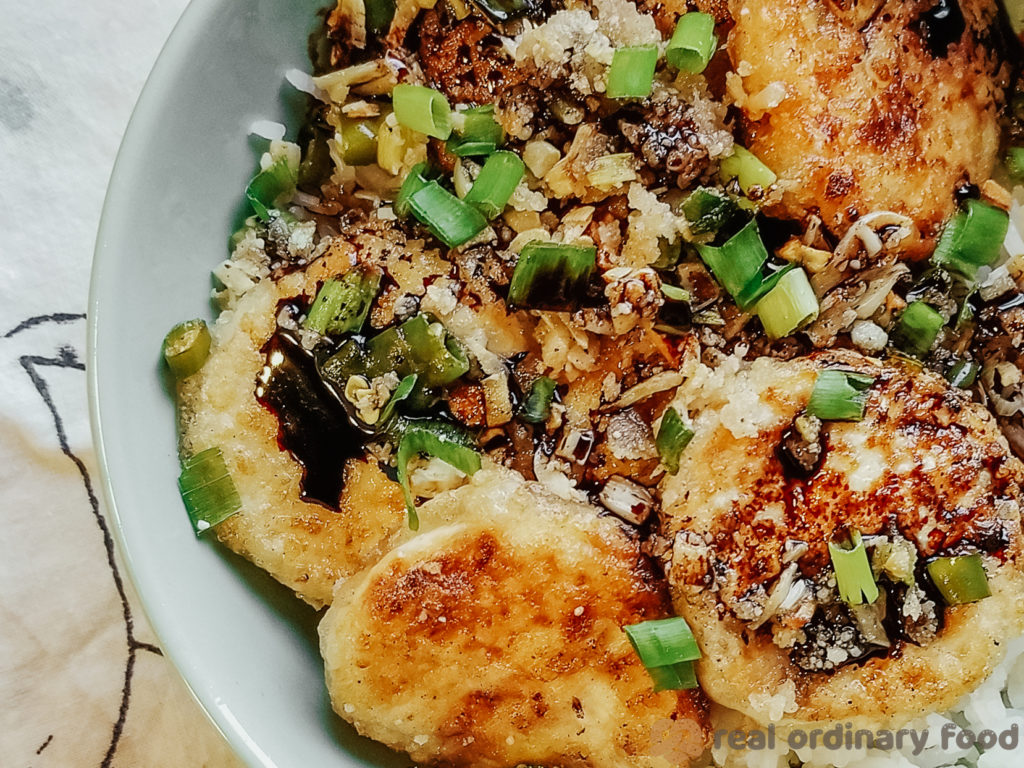
Recipe FAQs
In Korean, biji (비지) or kongbiji (콩비지) refers to soy pulp or soy lees, the insoluble fibrous part of soybeans that is strained out during the production of soy milk. Biji is commonly used as a base ingredient in a stew called kongbiji jjigae. The paste is typically made by grinding soaked soybeans into a fine consistency then straining it until only the solids remain.
In Korean cuisine, jigae (also spelled jjigae) refers to a type of stew or soup that is commonly enjoyed as a main dish. Jigae is typically made by simmering various ingredients together in a flavorful broth. The specific ingredients used can vary widely, ranging from tofu, vegetables, and mushrooms to meat, seafood, or a combination of these. Jigae often has a spicy or savory flavor profile, and it is typically served hot and accompanied by rice and other side dishes. It is a popular and comforting dish enjoyed in Korean households and restaurants alike.

Recipe Card
Did you make this recipe? Please consider leaving a rating below to let me know how you liked it.
You can also take a picture and tag me on Instagram @earthtoveg, I will shout you out in my Stories!

Kongbiji Jjigae (Okara Stew)
Use Imperial/Metric buttons below to toggle between volume vs weight measurements. I recommend weighing out your ingredients for best results.
Equipment
- 1 to 1.5 quart ttukbaegi (Korean earthenware pot) (or similar size Dutch oven or stockpot)
- skillet or frying pan
Ingredients
Yuksu Broth
- 1 cup water + more to add at the end
- 3 dried shiitake mushrooms
- 1 4×4 piece of kombu
Jjigae
- 1 tbsp oil
- ½ yellow onion, diced
- 2 cloves garlic, minced
- ¾ cup kimchi
- ¼ cup kimchi brine see Note 1
- ¼ tsp black pepper
- 1 to 2 tbsp guk-ganjang aka soup soy sauce see Note 2
- ½ cup packed okara 75 to 100g
- ¼ lb vegan beef *optional; see Note 3
Toppings
- 1 scallion, diced
- 1 tsp sesame oil
- gochugaru aka Korean chili flakes to taste
Instructions
- Combine 1 cup water, 3 shiitake mushrooms, and a 4×4 sheet of kombu in a ttukbaegi, stockpot, or Dutch oven. Bring this to a simmer on medium heat. (Once the water begins to boil, remove the kombu.)
- Pour 1 tbsp of oil into a skillet on medium heat. Briefly sauté onion and garlic until aromatic, then add 3/4 cup of drained kimchi. Cook for a few minutes, then transfer this sautéed mixture into the ttukbaegi.
- Add 1/4 cup kimchi brine, 1/4 tsp black pepper, 1 to 2 tbsp soy sauce, 1/2 cup okara, and 1/4 lb vegan beef or tofu. Simmer for 10 minutes, then turn off the stove and let the jjigae cook for another 5 minutes in the residual heat. If it looks too dry, you can add a bit more water.
- Garnish with diced scallions and drizzle over 1 tsp sesame oil and gochugaru. Taste for seasoning and add more soy sauce or gochugaru if needed. Serve with Steamed Rice (see Note 4).
Notes
- Kimchi Brine is the salty liquid that the kimchi is submerged in.
- Guk-Ganjang aka “soup soy sauce” is a special type of Korean soy sauce. It’s more salty and concentrated than other soy sauces, despite having a lighter colour. It’s perfect for seasoning vibrant soups and stews like this kongbiji-jjigae without affecting the colour of the dish. Find guk-ganjang at Korean grocery stores or order it online. You can also substitute it with regular soy sauce.
- Vegan Beef: I recommend using Beyond Steak Plant-Based Seared Tips, they take it to the next level. But you can also sub with fried tofu.
- Seasoning to Taste: Be generous with the soy sauce. Since kongbiji-jjigae is meant to be eaten with Plain Rice, it should be fairly salty, to the point of tasting a little over-salted on its own. When mixed together with rice, it will taste perfect!

This was tasty! I love all your Korean food recipes. Could you do doenjang jigae next?